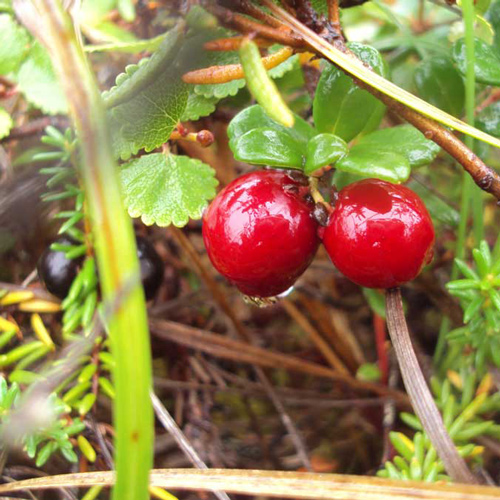Pvt. Collins brings cranberries for the sick, and an important Chinook chief, Tahcum, visits Fort Clatsop for the first time. Sgt. Ordway‘s detachment finishes their trek to the salt makers’ camp, and Lewis describes wolves and coyotes.
Tahcum Visits
by Yellowstone Public Radio[1]Originally aired weekdays by Yellowstone Public Radio during the Bicentennial observance of 2003-2006. Narrated by Hal Hansen. Scripts by Whit Hansen and Ed Jacobson. Produced by Leni Holliman. © … Continue reading
Cranberries
Vaccinium oxycoccos
Attributed to the Bering Land Bridge National Preserve. Permission to use granted under the Creative Commons Attribution-ShareAlike 2.0 Generic (CC-BY-SA 2.0) license.
Cranberries for the Sick
Permited Collins to hunt this morning he returned in the evening unsuccessfull as to the chase but brought with him some cranberries for the sick. Gibson is on the recovery fast; Bratton has an obstenate cough and pain in his back and still appears to be geting weaker. McNeal from his inattention to his disorder has become worse.
—Meriwether Lewis
Traveling to the Salt Works
we Set out eairly and proced. on along the coast faceing the wind the Sand cut our faces waided a creek rapid curret about noon we arived to the Salt works and bought a little Ecoley and oil &C from the natives.
—John Ordway
Tahcum Visits
we were visited by Tâh-cum a principal chief of the Chinnooks [Chinooks] and 25 men of his nation. we had never Seen this Chief before he is a good looking man of about 50 years of age reather larger in Statue than most of his nation; as he came on a friendly visit we gave himself and party something to eate and plyed them plenty fully with Smoke. we gave this chief a small Medal with which he Seamed much pleased.
—William Clark
Woven Hats
A number of the Chinook Indians came to the fort with hats to trade. They are made of the cedar bark and silk grass, look handsome and keep out the rain.
—John Ordway
Wolves and Coyotes
the large [wolf] and small woolves [coyotes] of the plains are the inhabitants principally of the open country and the woodlands on their borders and resemble in their habits and appearance those of the plains of the Missouri precisely.
—Meriwether Lewis
Weather Diary
aspect of the weather at rise
Wind at rise
aspect of the weather at 4 OC1 P.M. Wind at 4 O’Clock P.M. cloudy after rain S W cloudy after rain S. W. wind violent all night and the greater part of the day.
—Meriwether Lewis[2]To assist the reader, the editor of this web page has omitted the “Day of ye Month” column and spelled out some abbreviations.
Experience the Lewis and Clark Trail
The Lewis and Clark Trail Experience—our sister site at lewisandclark.travel—connects the world to people and places on the Lewis and Clark Trail.
Plan a trip related to February 20, 1806:

Fort Clatsop is a High Potential Historic Site along the Lewis and Clark National Historic Trail managed by the U.S. National Park Service. The site is managed by the Lewis and Clark National and State Historic Parks.
Notes
| ↑1 | Originally aired weekdays by Yellowstone Public Radio during the Bicentennial observance of 2003-2006. Narrated by Hal Hansen. Scripts by Whit Hansen and Ed Jacobson. Produced by Leni Holliman. © 2003 by Yellowstone Public Radio. |
|---|---|
| ↑2 | To assist the reader, the editor of this web page has omitted the “Day of ye Month” column and spelled out some abbreviations. |



